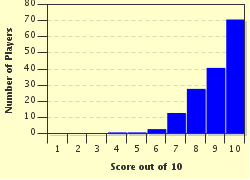Quiz Answer Key and Fun Facts
1. Billy Strayhorn wrote this 1941 hit that became the signature tune of Duke Ellington and his Orchestra. Which fast-moving song is it?
2. First released in 1938 by the Erskine Hawkins Orchestra, this jazz standard became a Billboard Number 1 hit for Glenn Miller and his Orchestra in 1940. Which well-dressed song is it?
3. Another Glenn Miller favourite, this time written by the man himself, was an immediate hit when it was released in 1939, and became known as his signature song. Which song?
4. The Andrews Sisters performed this song that was featured in the 1941 Abbott and Costello film, "Buck Privates". Which song, also nominated for an Oscar, is it?
5. Count Basie's 1955 rendition of this song is considered the most famous arrangement of many, but it was originally written in 1932 for the Broadway musical "Walk a Little Faster". Which song?
6. This timely 1937 jazz standard became Count Basie Orchestra's signature tune, closing their concerts for the next half century. What is it called?
7. The Woody Herman Orchestra had their greatest hit in 1939 with this up-tempo blues tune. What song?
8. Written by Irving Berlin for the 1926 musical "Betsy", this standard has been recorded by all the greats. What is the name of this song, that was also featured in the first ever feature-length talkie, "The Jazz Singer"?
9. Bing Crosby introduced this song to the world in the 1936 film of the same name. It also happened to get nominated for Best Song at the 1937 Oscars. Which song?
10. Hoagy Carmichael composed and recorded this song in 1927, then Mitchell Parish added the lyrics in 1929. What sparkling song is it?
Source: Author
reedy
This quiz was reviewed by FunTrivia editor
1nn1 before going online.
Any errors found in FunTrivia content are routinely corrected through our feedback system.
